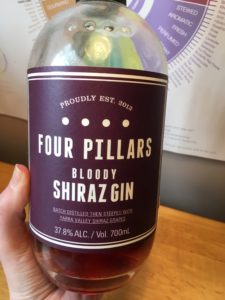 I have heard VERY good things about this gin. So when my housemate bought some of the 2017 vintage home, I was very excited. The Yarra Valley outside Melbourne, Australia, is home to a thriving wine growing community. Amongst the vineyards, you’ll find the Four Pillars distillery. They say that they base their craft distilling on four pillars – stills, water, botanicals and love. After years of research and testing, they released their Rare Dry Gin in December 2013, followed by a Barrel Aged Gin on World Gin day, 14 June 2014. On a roll, in 2014 they also released their 58.8% Navy Strength gin. Since then they have released their Bloody Shiraz gin, a spiced negroni gin, the modern Australian gin, a cardonnay barrel gin and a sherry cask gin. The Bloody Shiraz gin is closely tied to the wine industry around it, changing with each year’s vintage after the grapes are steeped in the gin for eight weeks. This gives it a rich red colour alongside notes of fresh pine, spice, and a touch of berry. Don’t confuse this with a sloe gin through – this still packs a punch at 37.8% ABV. Continue reading
I have heard VERY good things about this gin. So when my housemate bought some of the 2017 vintage home, I was very excited. The Yarra Valley outside Melbourne, Australia, is home to a thriving wine growing community. Amongst the vineyards, you’ll find the Four Pillars distillery. They say that they base their craft distilling on four pillars – stills, water, botanicals and love. After years of research and testing, they released their Rare Dry Gin in December 2013, followed by a Barrel Aged Gin on World Gin day, 14 June 2014. On a roll, in 2014 they also released their 58.8% Navy Strength gin. Since then they have released their Bloody Shiraz gin, a spiced negroni gin, the modern Australian gin, a cardonnay barrel gin and a sherry cask gin. The Bloody Shiraz gin is closely tied to the wine industry around it, changing with each year’s vintage after the grapes are steeped in the gin for eight weeks. This gives it a rich red colour alongside notes of fresh pine, spice, and a touch of berry. Don’t confuse this with a sloe gin through – this still packs a punch at 37.8% ABV. Continue reading
Gin reviews
Dam Raider Gin
Note: I contacted Lincoln Imp Drinks Co and they kindly sent me a bottle of their Dam Raider gin to try, as always I will let you know what I really think.
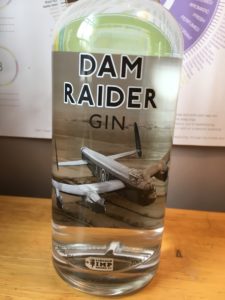 Dam Raider gin has an awesome bottle. At first glance, it just has a picture of a Lancaster bomber on the front. Hold it up and, thanks to 3D technology, you can see it flying over Scampton. The back label shows authentic extracts of a log book from a ‘Dambusters’ crew member. Lincoln Imp Drinks company created the gin to commemorate the Dambusters raid in World War II, and from every bottle of Dam Raider gin sold, a donation is made to the Thorpe Camp Visitor Centre – home of the squadrons that flew out of RAF Woodhall Spa in the 1940s. The gin itself has been made with juniper as the prominent note, along with five other botanical which feature citrus and warming spices. They say this blend leads to a “smooth, long palate” – so let’s see how it tastes.
Dam Raider gin has an awesome bottle. At first glance, it just has a picture of a Lancaster bomber on the front. Hold it up and, thanks to 3D technology, you can see it flying over Scampton. The back label shows authentic extracts of a log book from a ‘Dambusters’ crew member. Lincoln Imp Drinks company created the gin to commemorate the Dambusters raid in World War II, and from every bottle of Dam Raider gin sold, a donation is made to the Thorpe Camp Visitor Centre – home of the squadrons that flew out of RAF Woodhall Spa in the 1940s. The gin itself has been made with juniper as the prominent note, along with five other botanical which feature citrus and warming spices. They say this blend leads to a “smooth, long palate” – so let’s see how it tastes.
Arcturus Gin
Note: I contacted Arcturus gin and they kindly sent me a bottle to try. As always, you’ll know if I don’t like it!
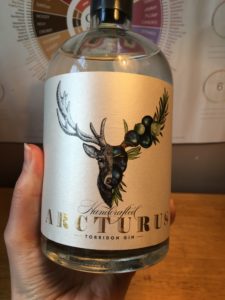 Arcturus gin is one of those bottles that you see and go “man, that’s a damn fine label”. I don’t like judging a book but its cover, but I do it all the time. If the label is anything to go by, the gin should be pretty good. Named after one of the brightest stars that can be seen from Earth, this Scottish gin is made using local highland botanicals that have been foraged and blended with water from Loch Torridon. The botanicals include Scots Lovage (similar to parsley), blaeberries (abundant in the Highlands) and kelp seaweed from the coast. Based in The Torridon Resort, a 58 acre hotel set in the heart of the highlands, this gin is as crisp and clear as the loch water and bottled at Dunnet Bay Distillery – best known for their Rock Rose gin.
Arcturus gin is one of those bottles that you see and go “man, that’s a damn fine label”. I don’t like judging a book but its cover, but I do it all the time. If the label is anything to go by, the gin should be pretty good. Named after one of the brightest stars that can be seen from Earth, this Scottish gin is made using local highland botanicals that have been foraged and blended with water from Loch Torridon. The botanicals include Scots Lovage (similar to parsley), blaeberries (abundant in the Highlands) and kelp seaweed from the coast. Based in The Torridon Resort, a 58 acre hotel set in the heart of the highlands, this gin is as crisp and clear as the loch water and bottled at Dunnet Bay Distillery – best known for their Rock Rose gin.
Archangel Gin
Note: I contacted Archangel and they kindly sent me a sample to try, as always I’m still going to be honest about the taste
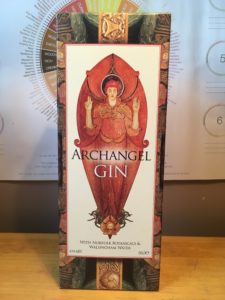 Archangel gin hails from Norfolk and has just celebrated its first birthday, being first batched up on 2 February 2017. They distil their gin on a working farm just a hundred yards from St. Peter’s church which dates back to the 14th century. The farm has been in the Archangel family for the last 60 years and they are Norfolk born and bred and believing in small scale productions using local labour and locally sourced ingredients. The juniper and sea buckthorn are grown on site and are with blended 11 other botanicals including verbena and orange peel.
Archangel gin hails from Norfolk and has just celebrated its first birthday, being first batched up on 2 February 2017. They distil their gin on a working farm just a hundred yards from St. Peter’s church which dates back to the 14th century. The farm has been in the Archangel family for the last 60 years and they are Norfolk born and bred and believing in small scale productions using local labour and locally sourced ingredients. The juniper and sea buckthorn are grown on site and are with blended 11 other botanicals including verbena and orange peel.
British Polo Gin
Note: I contacted British Polo gin and they kindly send me some samples, and a copy of the British Polo magazine, to try. As always, this won’t stop me being honest about what I taste!
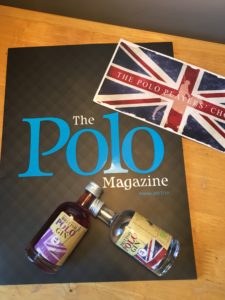 British Polo gin is apparently the polo players’ choice of gin…and so therefore I’m going to give it a go. To be fair, I grew up in the countryside and we had a horse growing up, so I’m basically qualified to make this judgement. Founded by polo player Richard Hine, British Polo gin is 100% organic using 100% organic botanicals and base spirit (distilled from sugar beet which also makes it gluten free) which is then quadruple distilled for smoothness before being diluted with natural spring water from the land around their distillery. They make their gin in batches of just 150 bottles which contain 14 botanicals ranging from elderflower to vanilla and cinnamon. They have also launched a sloe gin distilled with British berries with additions of winter spices cinnamon, nutmeg and cloves which already has me dreaming of cosy jumpers and roaring fires.
British Polo gin is apparently the polo players’ choice of gin…and so therefore I’m going to give it a go. To be fair, I grew up in the countryside and we had a horse growing up, so I’m basically qualified to make this judgement. Founded by polo player Richard Hine, British Polo gin is 100% organic using 100% organic botanicals and base spirit (distilled from sugar beet which also makes it gluten free) which is then quadruple distilled for smoothness before being diluted with natural spring water from the land around their distillery. They make their gin in batches of just 150 bottles which contain 14 botanicals ranging from elderflower to vanilla and cinnamon. They have also launched a sloe gin distilled with British berries with additions of winter spices cinnamon, nutmeg and cloves which already has me dreaming of cosy jumpers and roaring fires.
Cuckoo Gin
Note: I contacted Brindle Distillery and they kindly sent me a bottle of Cuckoo gin to try. This won’t influence my tastebuds though.
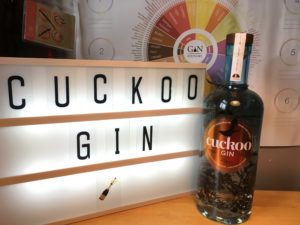 Based in Lancashire, Brindle Distillery produce Cuckoo Gin – a gin with sustainable and ethically-sourced botanicals and named after a local legend. The Brindle Cuckoo hails back to the middle ages when hearing the first cuckoo’s call of spring led to celebrations that the fertility of the land would reward the farm workers. So, obviously, the locals decided to catch one to keep in the village to bring them luck all year round – except the cuckoo was smart and flew off. Now, anyone born and bred in Brindle is known as a Brindle Cuckoo. They keep this theme running with locally grown botanicals from the surrounding fields and their natural water source delivers spring water straight to the distillery. Being ecologically minded doesn’t stop there; they heat their still, Maggie, with renewable energy biomass boilers and they feed any distilling byproducts to their cattle and chickens. They say their gin is smooth with flavours starting at juniper and developing to citrus, spice and pepper. Let’s see how it fares…
Based in Lancashire, Brindle Distillery produce Cuckoo Gin – a gin with sustainable and ethically-sourced botanicals and named after a local legend. The Brindle Cuckoo hails back to the middle ages when hearing the first cuckoo’s call of spring led to celebrations that the fertility of the land would reward the farm workers. So, obviously, the locals decided to catch one to keep in the village to bring them luck all year round – except the cuckoo was smart and flew off. Now, anyone born and bred in Brindle is known as a Brindle Cuckoo. They keep this theme running with locally grown botanicals from the surrounding fields and their natural water source delivers spring water straight to the distillery. Being ecologically minded doesn’t stop there; they heat their still, Maggie, with renewable energy biomass boilers and they feed any distilling byproducts to their cattle and chickens. They say their gin is smooth with flavours starting at juniper and developing to citrus, spice and pepper. Let’s see how it fares…
Lakes Gin – Explorer Edition
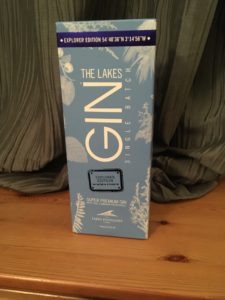 A while ago, Lakes gin kindly sent me a sample of their delicious gin (review of which you can read here). They have a range of spirits in their collection including a whisky and a vodka. My housemate kindly bought home a bottle of their Explorer gin for me to try. This is a special edition gin produced from a single batch distillation using juniper grown in Cumbria and another four botanicals which are native to the Lake District National Park. Their original gin has 10 botanicals in total with an ABV of 43.7% and the Explorer edition bumps this up to 15 botanicals and 47.1% ABV. This gives it a long and aromatic finish with zesty, herbal notes.
A while ago, Lakes gin kindly sent me a sample of their delicious gin (review of which you can read here). They have a range of spirits in their collection including a whisky and a vodka. My housemate kindly bought home a bottle of their Explorer gin for me to try. This is a special edition gin produced from a single batch distillation using juniper grown in Cumbria and another four botanicals which are native to the Lake District National Park. Their original gin has 10 botanicals in total with an ABV of 43.7% and the Explorer edition bumps this up to 15 botanicals and 47.1% ABV. This gives it a long and aromatic finish with zesty, herbal notes.
Elg No. 4 Gin
 Now, you may have already read my blog posts about Elg gin No. 1, No. 2 and No. 3. Today we try the fourth gin in their range. You probably know my feelings about colour changing gin; it’s usually achieved by adding something to the distillation that has no effect on the flavour and is only added for the colour. This gin is different. Elg gin uses three botanicals – juniper, coriander seed and Danish carrots and the only difference between their No. 1 gin and this one is that the carrots used are Danish black carrots. These are soaked in pure wheat alcohol for three days which results in the rich colour which is filled with natural antioxidants. I know that this is still done for the colour, but at least the botanical is also adding the flavour – and it is the same botanical as their usual recipe. Let’s see how this one compares to the rest.
Now, you may have already read my blog posts about Elg gin No. 1, No. 2 and No. 3. Today we try the fourth gin in their range. You probably know my feelings about colour changing gin; it’s usually achieved by adding something to the distillation that has no effect on the flavour and is only added for the colour. This gin is different. Elg gin uses three botanicals – juniper, coriander seed and Danish carrots and the only difference between their No. 1 gin and this one is that the carrots used are Danish black carrots. These are soaked in pure wheat alcohol for three days which results in the rich colour which is filled with natural antioxidants. I know that this is still done for the colour, but at least the botanical is also adding the flavour – and it is the same botanical as their usual recipe. Let’s see how this one compares to the rest.
Sacred G&T
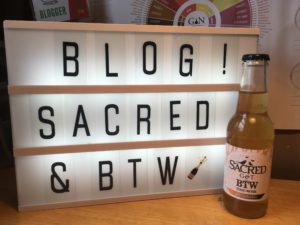 Remember the days of premixed drinks? My drink of choice as a teen was Smirnoff Ice, because I was classy. Nowadays, premixed drinks are making a comeback with all of the big brands and supermarkets getting in on the trend with tins of premixed gin and tonic (always go for the M&S pink gin FYI). Entering this market is the London-based collaboration between Sacred gin and BTW tonic. The bottle is certainly distinctive – the colour of BTW tonic comes from the use of natural quinine in their product. Sacred gin comes from the smallest commercial distillery and has quite the extensive range of flavoured gins to its name and this premix highlights the pink grapefruit to add a freshness and a bright citrus flavour.
Remember the days of premixed drinks? My drink of choice as a teen was Smirnoff Ice, because I was classy. Nowadays, premixed drinks are making a comeback with all of the big brands and supermarkets getting in on the trend with tins of premixed gin and tonic (always go for the M&S pink gin FYI). Entering this market is the London-based collaboration between Sacred gin and BTW tonic. The bottle is certainly distinctive – the colour of BTW tonic comes from the use of natural quinine in their product. Sacred gin comes from the smallest commercial distillery and has quite the extensive range of flavoured gins to its name and this premix highlights the pink grapefruit to add a freshness and a bright citrus flavour.
Elg No. 3 Gin
 You may have seen that I’ve already tried Elg No. 1 (traditional gin) and Elg No. 2 (Old Tom) and so today we – rather logically – move on to the third in their range. Elg No. 3 is a mighty 57.2% – using the same three-botanical recipe but diluted with less water. This additional ABV is designed to give the gin a much more intense flavour and aroma.
You may have seen that I’ve already tried Elg No. 1 (traditional gin) and Elg No. 2 (Old Tom) and so today we – rather logically – move on to the third in their range. Elg No. 3 is a mighty 57.2% – using the same three-botanical recipe but diluted with less water. This additional ABV is designed to give the gin a much more intense flavour and aroma.